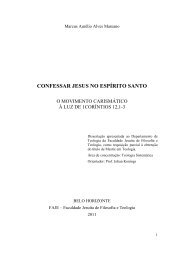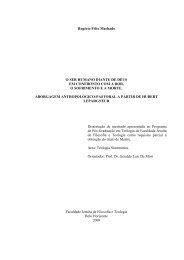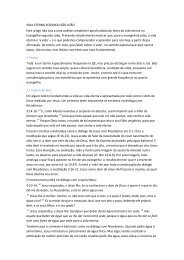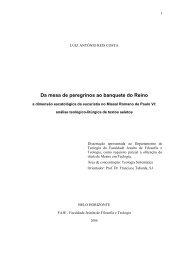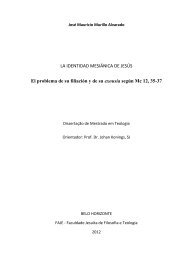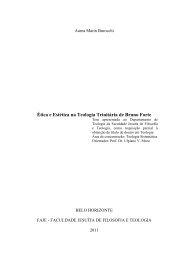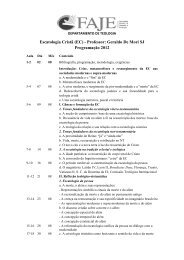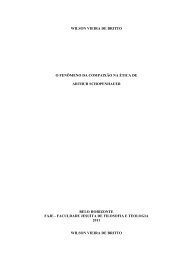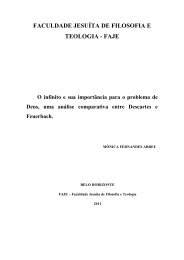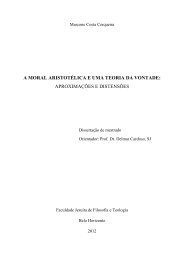o teÃsmo e o problema do mal em richard swinburne - FaJe
o teÃsmo e o problema do mal em richard swinburne - FaJe
o teÃsmo e o problema do mal em richard swinburne - FaJe
You also want an ePaper? Increase the reach of your titles
YUMPU automatically turns print PDFs into web optimized ePapers that Google loves.
é contrastada é sua negação. Daí se segue a relação entre crença e<br />
probabilidade, já que para ser admitida como plausível, a proposição deverá<br />
ser mais provável <strong>do</strong> que a sua alternativa, ou seja, sua probabilidade deverá<br />
ser maior <strong>do</strong> que ½. A proposição certa seria um caso extr<strong>em</strong>o no qual a sua<br />
probabilidade é igual a 1, já que a probabilidade da alternativa é nula.<br />
Esse princípio está de acor<strong>do</strong> com a inclinação que t<strong>em</strong>os <strong>em</strong> aceitar<br />
como verdadeiro aquilo que se apresenta como plausível para nós, pois a<br />
plausibilidade de uma proposição faz com que a tenhamos como verdadeira.<br />
A relação entre crença e probabilidade está submetida a uma gradação.<br />
Quan<strong>do</strong> a probabilidade de uma proposição é muito grande, pode-se crer nela<br />
com relativa certeza. Mas se tal probabilidade supera por pouco a de sua<br />
alternativa, pode-se hesitar <strong>em</strong> afirmá-la. Entretanto, Swinburne considera que<br />
o uso <strong>do</strong> termo “crer” é legítimo s<strong>em</strong>pre que uma proposição é mais provável,<br />
mesmo que sua probabilidade seja pouco superior à da sua negação. 38<br />
1.2. As formas de probabilidades.<br />
O princípio de probabilidade é nor<strong>mal</strong>mente usa<strong>do</strong> para examinar se<br />
algumas conclusões pod<strong>em</strong> ser tidas como verdadeiras, se elas traz<strong>em</strong><br />
condições suficientes para isso. Uma escolha dentro de um quadro<br />
probabilístico nos leva a fazer a opção pelo tipo de análise que habilita as<br />
conclusões a se preservar<strong>em</strong> com certa correção.<br />
that p is not probable, I cannot believe that p—that is, that p is true.” (SWINBURNE, Richard.<br />
Epist<strong>em</strong>ic Justification. Oxford:. Claren<strong>do</strong>n Press, 2001, pp.34-35).<br />
38 “Suppose that I <strong>do</strong> believe that p is probable. Must I believe that p Clearly, if either I am to<br />
believe that p or I am to believe that not-p, I must believe the former. But might I not believe that<br />
p is probable without believing that p or believing that not-p If I believe that p is very, very<br />
probable, surely I believe that p. Cases where we would say the former are always cases where<br />
we would say the latter.[...] The only difficulty arises when I believe that p is marginally more<br />
probable than not. Here we might be hesitant about whether to say that I believe that p. The<br />
hesitation arises, not from ignorance about any unobserved matters, but because the rules for<br />
the application of the concept of belief are not sufficiently precise. Maybe some people <strong>do</strong> use<br />
‘believe’ so that (given that S has some belief about the probability of p) S has to believe that p<br />
is significantly more probable than not if S is to believe that p. But certainly others are prepared<br />
to allow that S believes that p if S believes merely that p is marginally more probable than not. It<br />
se<strong>em</strong>s tidier to follow this latter usage. For, if we <strong>do</strong> not follow this usage, there would have to<br />
be some value of probability between ½ and 1, such that only if S (having a belief about p's<br />
probability) had the belief that p had a probability greater than would he believe that p. But any<br />
value chosen for would be extr<strong>em</strong>ely arbitrary. I conclude that, although our ordinary rules for<br />
the use of words may not be.” (SWINBURNE, Richard. Epist<strong>em</strong>ic Justification. Oxford:.<br />
Claren<strong>do</strong>n Press, 2001, p.35).<br />
45



